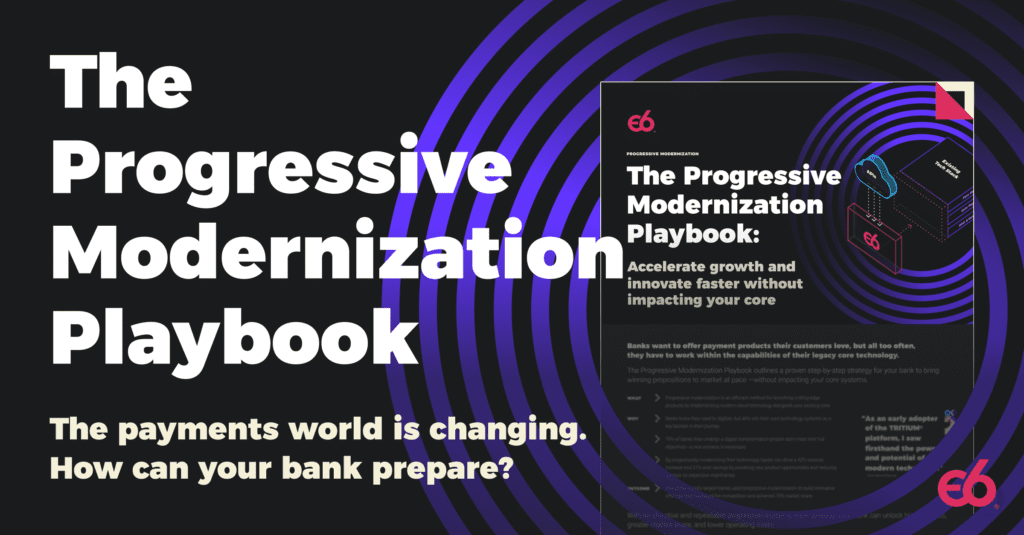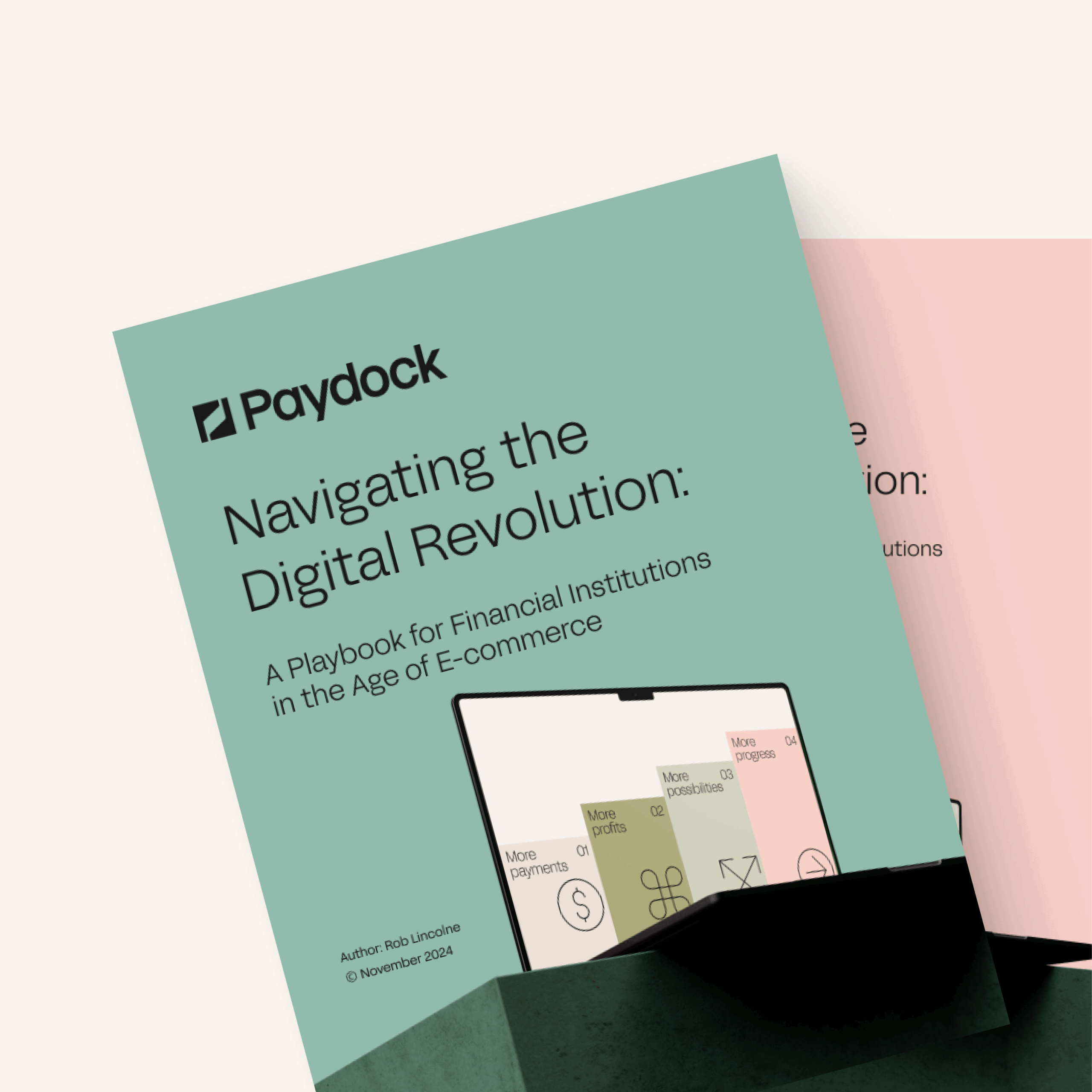Executive summary
Banks want to offer payment products their customers love, but all too often, they have to work within the capabilities of their legacy core technology. The Progressive Modernization Playbook outlines a proven step-by-step strategy for your bank to bring winning propositions to market at pace —without impacting your core systems.
Key insights include:
- What
- Progressive modernisation is an efficient method for launching cutting-edge products by implementing modern cloud technology alongside your existing core.
- Why
- Banks know they need to digitise, but 40% cite their core technology systems as a key blocker in their journey
-
- 70% of banks that undergo a digital transformation project don’t meet their full objectives—a new process is necessary
-
- By progressively modernising their technology, banks can drive a 42% revenue increase and 21% cost savings by powering new product opportunities and reducing reliance on expensive mainframes
- Outcome
-
- One of the world’s largest banks used progressive modernisation to build innovative offerings that outpaced the competition and achieved 70% market share.
With an effective and repeatable progressive modernisation strategy, your bank can unlock higher profits, greater market share, and lower operating costs.
Introduction
The payments world is changing. Competition is rising, and customers expect more from their banks and financial institutions (FIs).
While banks once monopolised payment products, tech disruptors have shaken the space and raised customer expectations for convenience and personalisation. They’ve captured many banking customers with compelling digital-first offerings, such as Buy Now, Pay Later (BNPL) services, embedded finance solutions, and digital wallets. These disruptors have become customers’ first choice for financial products thanks to their intuitive digital experiences, pushing banks to the back. To secure their position against these challengers and take back customer engagement, banks need to respond with market-leading products of their own.
However, product development is easier said than done. Banks’ product ambitions are often stunted by technology, budget, and timeline constraints. While banks drove cutting-edge financial technology development in the 20th century, many still use the same decades-old infrastructure today. Legacy systems that enabled innovation in the past are limiting it today, as their rigid structure can’t keep up with the pace of market demands. Over 80% of banks’ development budgets are typically consumed by regulatory changes, constraining their ability to innovate. What little effort banks can devote to new product development is costly and time-consuming, thanks to their outdated technology.
Banks don’t have to accept this status quo. Instead, banks have several built-in advantages that can give them an edge over the competition, including:
- Strong brands and trust
- Deep customer relationships
- Secure and resilient technology
There’s one key ingredient to maximising these strengths and unlocking your bank’s full potential: progressive modernisation. While legacy platforms bury your advantages under inefficient architecture and slow product roadmaps, implementing a new platform can give you the agility and flexibility you need to quickly develop products your customers love. All it takes is the right modernisation strategy.
Q&A: Brian Muse-McKenney, CRO, E6
Brian Muse-McKenney is a dynamic banking leader with a 16-year track record of creating and scaling new products worldwide. Formerly Chief Innovation Officer at HSBC Global Payments Solutions, Chief Executive of PayMe from HSBC, and Vice Chairman of Swift UK, Brian drives E6’s global growth as Chief Revenue Officer.
- Where are banks on their modernisation journeys?
Many banks have embraced the need to modernise and leverage the cloud. However, most banking cores still have the same monolithic systems that banks used in the late twentieth century. They do what they do very well, but any functional changes require time-consuming development, integration, and testing cycles. As such, few banks have unlocked the benefits of the cloud at scale, because their legacy technology still hampers them.
- What are the benefits of using the cloud?
The cloud can enable banks to build better customer experiences. Customers don’t want to pick up the phone or visit a branch whenever they want to manage their account. With real-time cloud infrastructure, banks can build fully digital-first experiences that don’t require any human interaction. Not only can this approach provide convenient services for customers, but when done right, it can also cut cost for the bank both technically and operationally.
- How can banks start benefitting from the cloud?
Taking advantage of a new cloud-based platform is crucial. However, moving your technology to the cloud doesn’t benefit customers. To support your customers, you need to develop new products and experiences. But how can you do that without replacing the core, the heart of the bank? That’s where progressive modernisation comes in.
The Legacy of Legacy
At a time when banks need to adapt, legacy technology is the gift that keeps on taking.
Banking used to represent the cutting edge of technology. However, something shifted as banks continued renewing their contracts with their infrastructure providers over the years. The advent of cloud computing in the mid-2000s ushered in a new era of technology possibilities. Customer demands changed, competition intensified, and new products entered the market—but banking systems remained largely the same. In an industry where compliance and security are paramount, banks focus on preserving their technical status quo instead of pursuing transformative change. While this move felt safe, it opened FIs up to new challenges.
Infrastructure that once helped banks lead the market is now holding them back. According to research by IDC, 40% of banks cite legacy technology as a major roadblock in their digital transformation efforts—and it’s not hard to see why. Legacy technology limits banks’ abilities to respond to market changes with inefficiencies and challenges such as:
- Rigid architecture
- Lack of scalability
- Slow development
- Unable to easily support new products
- Time-consuming change requests
- Expensive maintenance
- Hard-coded functionality
- Limited support
At the same time, legacy tech promises to drain banks’ already tight budgets. IDC projects that banks will spend $57.1 billion per year just to maintain their legacy systems by 2028. On top of that, this cost is expected to continue growing by an average of 7.8% per year going forward. Banks already devote so much of their annual budget towards regulatory compliance updates, and if legacy expenses keep climbing, they’ll have little left over for new product development or customer experience improvements.
These challenges make it difficult for FIs to keep pace with the constantly evolving payments landscape. Meanwhile, fintechs (and their modern cloud-based tech stacks) exploit this situation to chip away at banks’ profit centres. According to Capgemini, 75% of customers prefer fintech competitor apps because they offer faster, more convenient products and experiences than the banking alternatives.
For banks, something must change. Taking the same approach to your core banking technology is not sustainable. Instead, the modernisation of banking technology is pivotal to securing your organisation’s future success. There’s just one question now: how can banks get there?
75% of bank customers prefer fintech competitor apps. (Source: Capgemini)
Pathways to modernisation
Payments modernisation is nothing new. Since banking technology first hit the market, FIs have constantly worked to update and refine their existing products. However, it’s time for a new approach. Research by McKinsey found that only 30% of banks that underwent a technology transformation process actually implemented their full strategy. Technical debt, complicated migrations, misaligned business and IT teams, ballooning expenses, and slow product release schedules can all keep banks from achieving their technical ambitions. Banks need a more efficient path to make the most of modern technology.
When done right, technology transformation can unlock enormous growth. According to IDC, banks implementing new payments technology can see revenue grow by a staggering 42%. With features like application programming interfaces (APIs) and cloud infrastructure, modern payment platforms can give banks the flexibility to accelerate their product roadmaps while cutting out the inefficiencies of legacy tech.
As with any major technology decision, FIs who decide to use modern payments technology must choose their implementation strategy. There are two primary options, each offering distinct levels of risk, effort, and time commitment:
| Core modernisation | Progressive modernisation |
| When FIs talk about updating their technology, this approach usually comes to mind. A core modernisation process is like a heart transplant. In this approach, the bank rips out its entire core infrastructure, replaces it with a modern cloud platform, and migrates its existing customer, account, and card data to the new system.
This option may be viable for smaller, less complex banks, but for larger FIs, it can be incredibly risky and disruptive. Replacing a bank’s core can take years of development time, putting all other product initiatives on hold. At the same time, there’s the risk that sensitive customer data won’t be properly migrated to the new platform. While core modernisation is sometimes unavoidable, it shouldn’t be attempted without careful planning and preparation. |
In many cases, there’s no need to rip out an entire tech stack. Instead, progressive modernisation can offer a less disruptive pathway to the future. The bank integrates a modern, cloud-based platform alongside its existing core in this approach. The new platform works like a sidecar, running simultaneously as the preexisting systems. The bank can launch new use cases on the modern platform without even touching the core.
Progressive modernisation decouples your product development from the core, allowing you to benefit from 21st-century technology without a costly and time-consuming core replacement. Once you’ve completed your first modern use case, you can use your new platform to launch additional products and migrate existing functionality easily. This empowers you to deliver growth at pace while mitigating risk. |
Banks that implement new payments technology can see revenue grow by a staggering 42%.
Source: IDC
“The space moves so quickly that by the time you complete a core replacement, your technology’s already outdated again. What was meant to be a ‘future-proof solution’ is now considered legacy tech in five years’ time.” – Dan Phillips
Q&A: Matt Little, VP of Product
Matt Little is the E6 global product lead with over ten years of experience in delivering innovative digital banking and e-commerce solutions for FIs in markets worldwide, including working with the top 4 consultancy groups.
- What are the limits of core modernisation?
Imagine if you started a core modernisation project right before the iPhone came out. Moving to a new core can take six or seven years and cost millions of dollars—and consumer expectations can change dramatically in that time. I’ve seen banks finally conclude a migration project only to realise that they’d reduced scope and cut projects along the way because it went over budget and the schedule dragged on.
- Why doesn’t core modernisation achieve what banks want?
I’ve never seen a core modernisation project unlock better customer experiences and new business possibilities. Core modernisation efforts are considered an IT project in most banks. As a result, many features that business teams need get left out, because they’re considered secondary to the actual migration. To make the most out of modernisation, technology and business need to be partners—not separate entities. A bank should be a technology-enabled business where IT provides products and solutions to drive business growth.
- How can banks improve their core technology?
It starts by not imagining a core as a single system anymore. Instead, the new core is a combination of specialised providers and systems. Rather than using one monolithic platform that scores a 3 out of 10 on each function, you can achieve a perfect 10 in each area by implementing best-in-class cloud-based platforms that help you differentiate and develop your business.
- How can banks balance stability and modernisation?
The core is still fundamentally important to running an effective bank, but with an important caveat. Don’t make it do everything. Let it handle key functions where it excels – like process orchestration and general ledger. When it comes to innovation and meeting new customer needs, that’s where you leverage cloud-based technology. Progressive modernisation allows you to extract key features from your core, so you can drive innovation without losing your foundation.
The Case for progressive modernisation
Technology transformation isn’t a decision to make lightly. It’s crucial to choose a modernisation strategy that can amplify your bank’s unique strengths and enable you to reach your goals without impacting your current processes.
On nearly every front, progressive modernisation provides an efficient and effective option. The approach offers significant advantages for banks:
- Minimising your risk exposure by providing a less jarring cutover to modern technology
- Cutting costs by distributing the upgrade over several smaller phases
- Extending the life of your legacy technology by moving critical systems and processes into a more agile and resilient environment
- Reducing your total cost of ownership from technology architecture
These strengths translate to massive business benefits. By optimising your operations, progressive modernisation will drive new product growth. Here’s how this approach can support your whole business:
Accelerate speed to market
When you’re developing against a legacy system, you’re confined to preset rules written for a pre-digital generation. This can restrict your product roadmap. Meanwhile, a new platform can offer cloud-based and API-enabled technology, allowing you to bring new products to market within weeks, not years.
Gain a competitive edge
Unlike legacy systems, modern platforms let you easily upgrade existing products with new abilities like rewards, controls, and interest segments. APIs and UI admin portals allow you to configure new offerings without large-scale development or customisation. This flexibility gives you an edge by letting you quickly pivot to new trends and demands.
Lower risk
Reap the benefits of new technology— minus the risk. Integrating a new platform as a sidecar allows you to keep your core intact and open new growth opportunities without requiring a costly migration.
Reduce expenses
As legacy platforms age, banks must invest in expensive, specialised resources just to keep their hardware running. Modernisation can reduce these costs by reducing reliance on old technology, lowering expenses by 21%, according to IDC.
Simplify data integration
A progressive modernisation model lets you maximise what you already have. You can enable interoperability between your systems, letting your new platform access all your crucial customer, card, and transaction data without performing a migration.
“Progressive modernisation can de-risk your transformation efforts while driving near-term ROI.” – Brian Muse-McKenney
Q&A: Dan Phillips, sales director
Dan Phillips has 14 years of international experience in the banking industry. He has worked in customer-facing, risk, and operational leadership roles, where he’s focused on meeting customer needs with market-leading propositions.
- How are financial services addressing new customer demands and trends?
Moving money is central to everyday life, but it’s becoming increasingly digital every year. People and businesses want to make that exchange as seamless as possible. It’s about providing payment at the point of need: at any point in a journey, whether that’s in an app, website, or physical store, you can make the payment in whatever way is more convenient to you. As such, there’s a need for financial services innovation to make things easier, cheaper, and more accessible for end users.
- What challenges are banks facing as they capitalise on these trends?
Traditional ways of thinking about banking aren’t as relevant as they once were. Rather than continuing to do things the way they’ve always been done, it’s crucial to carry forward an innovation mindset to solve customer needs.
- How can progressive modernisation help banks develop an innovation mindset?
By decoupling your products and services from the core, you can start introducing next-gen capabilities without embarking on a rip-and-replace project. With cloud-native technology, you can launch modern products like virtual accounts, BNPL, digital wallets, and tokenised cards—all of which are difficult to create on mainframe legacy cores. With this approach, it’s far quicker to get to market with solutions that customers demand.
- What can banks do to design better customer-focused products?
Start with the customer. What day-to-day challenges do they face when moving money between people or financing a business? Instead of settling for the status quo, look at things differently. By selectively modernising your technology and leveraging real-time data, you can better understand customer needs and create better products.
HSBC PayMe: Streamlined for success
In a bustling city like Hong Kong, shoppers are constantly on the go and need options to pay quickly and conveniently. HSBC was uniquely positioned to capitalise on this demand as one of the world’s largest banks. However, HSBC faced competition from new market entrants like Alipay and WeChat Pay, which threatened the bank’s market share.
HSBC responded with their own peer-to-peer (P2P) payments app, PayMe. However, PayMe was initially built on mainframe technology. It experienced stability issues at launch and couldn’t support the app’s growing customer base. It quickly became clear that HSBC needed a new strategy to make PayMe a success.
HSBC partnered with Episode Six (E6), a global wallet and card issuance technology provider, to build the bank’s first cloud-native product. The bank took a progressive modernisation approach and migrated its existing PayMe users to the new platform with no customer impact. With the power and flexibility of the E6 TRITIUM® platform, HSBC expanded the proposition and created a new P2M offering called PayMe for Business. This allowed in-person QR-Code and eCommerce payments with rewards and promotions and enabled the solution for both large complex merchants and small businesses.
As a result, PayMe dramatically outpaced the competition and became the top payments app in Hong Kong, achieving a 70% market share. Today, “PayMe” isn’t just a product—it’s a verb, a part of everyday life in Hong Kong.
“With PayMe, we have re-imagined digital payments, enabling our customers and merchants to transact seamlessly within an engaging digital platform. E6 enables banks, fintechs, and the broader business community to design effective digital journeys with efficiency.” – Catherine Zhou, Global CIO, Wealth and Personal Banking at HSBC
Dream big, start small: implementing progressive modernisation
Once you’ve chosen progressive modernisation as the best approach for your organisation, you can start mapping a path forward. A successful progressive modernisation project starts with five general stages:
1. Choose a strong first-use case
You need to start strong to prove the value of a modernised platform. Carefully select a debut use case that can retain existing customers while also enabling new customer acquisition in the future. Follow these six principles to design a winning new product:
- Identify: Start by identifying a compelling customer need. For example, to reach Gen Z customers, you might focus on that demographic’s need to build better credit by offering a secured credit card.
- Clarify: What’s your primary differentiator in the market? Use it to your advantage. Come up with a clear edge to express both in your product design and customer messaging. A regional bank, for instance, could leverage its local knowledge to hyper-tailor its products to the needs of its community.
- Plan: Determine the economics of your market opportunity so you can allocate resources effectively. Establish figures like the total addressable market (TAM), revenue models, and budget to assess the scope of your upcoming product.
- Stay adjacent: Ambition is one thing, but playing to your strengths is crucial when modernising your technology. Choose a use case adjacent to your current offerings so you can build on the work you’ve already done.
- Building blocks: Don’t let this be a one-and-done project. Design your new product with building blocks that can be reused for future offerings. For example, if you issue consumer credit cards this year, you’ll gain the issuing and processing capabilities you need for other card products, such as commercial or prepaid cards.
- Speed to market: Speed is critical to gaining a positive ROI from modernisation. Select a use case that you can feasibly design and launch within 12 months. This will make your product easier to implement and also let you start seeing results quickly.
2. Identify your business requirements
What do you want from modern technology? Modernisation isn’t a goal on its own. Rather, it should be a means to a larger business goal. With your first use case, you should identify what your product is meant to accomplish. Do you need new infrastructure so you can fill a gap in your product offering? Are you looking to defend against a particularly strong competitor? Or do you want to make inroads with a certain customer segment? Every feature should support your objective, from card design to interest rates.
3. Get help and find a partner
Once you’re ready to bring your use case to life, you’ll need some help. Especially if this is your first time launching a cloud-based project at scale, having a reliable cloud infrastructure provider on your side is key. Choose a provider that offers the capabilities you need to launch a competitive product today while empowering your roadmap for the future. For example, if you’re a commercial bank looking to lend to small and medium enterprises (SMEs), choose a provider that supports loan calculation and management.
Top 5 questions to ask
If you’re selecting a provider through a competitive process like a Request for Proposal (RFP) or just asking about their capabilities, here are five questions to ask to ensure you make the right selection:
- Does your platform support system-to-system API access? APIs provide a streamlined and scalable model for integrating cloud technology, so the right partner will expose all the product abilities you need via API connections.
- How can your platform support a rich, digital-first payments product? Customers want responsive mobile apps and intuitive digital experiences, so a good cloud provider can help you power these offerings with features like real-time notifications and instant payment approval.
- What is your approach to helping us launch new products within your platform? Your bank should be able to launch and configure new products securely and controlled, preferably with minimal or no supplier engagement.
- How does your product architecture support diverse use cases? The best cloud partners provide a common global platform that offers a range of products and capabilities, with a single data model and set of integrations that can simplify your end-to-end solution.
- What would that process look like if we wanted additional integrations in the future, such as a new payment rail? Your provider should have an established process for managing and implementing new integrations, allowing them to scale along with your business.
4. Work as one team
It can be easy to view technology modernisation as a strictly IT function. However, it’s key to think both horizontally and vertically. Don’t silo your IT team to work on infrastructural upgrades while your business team chases growth opportunities. Instead, have your IT and business teams work together as one organisation.
This might not seem intuitive at first. After all, these two groups usually perform completely different tasks. However, modernisation isn’t a one-off project. It’s a cultural change. The ideal state for any bank is to be a technology-enabled organisation, where your robust infrastructure can enable business innovation.
Coordinating your business and IT functions can take several forms. For example, you can schedule routine meetings between teams to synchronise your efforts and ensure that your business and technical goals are aligned. Transparency between teams and how each project contributes to overall business objectives is key. No matter how you choose to implement it, aligning your teams can maximise efficiency and effectiveness.
5. Design and launch your product
With your selected use case, business requirements, technology provider, and aligned teams, you’ll be ready to start bringing your new, modernised product to market. Here are a few considerations as you work towards your first big product launch:
- Integrate your new platform: Implement your new cloud-based platform with connections to your existing core. Create data integrations between your systems so that vital information can seamlessly pass between your new and legacy platforms. The new platform thus becomes the system of record for any accounts associated with your new product, so it can scale without burdening your core.
- Measure your progress: Milestones and metrics are key to steadily meeting your goals. Establish a framework like Objectives and Key Results (OKRs) for each task of your modernisation project. With an OKR process, your team works towards one main goal, with smaller “key results” supporting the primary objective. No matter what system you choose, measuring your progress can help you stay on track to complete your project efficiently.
- Address challenges head-on: Modernisation should mitigate technical debt, not contribute to it. That’s why you should tackle technical challenges head-on during implementation. Don’t let infrastructural issues add up. Instead, address technical and logistical challenges as they arise so you can minimise your project’s technical issues and ensure its lasting stability.
Long-term transformation
Your business transformation has only just begun once you’ve brought your new proposition to market. To make modernisation a success over the long term, follow this three-step process:
Focus on customer needs
It all starts with customer needs. To continue improving your product offering, your organisation needs to be laser-focused on delivering what your customers want from their financial products. When done right, this can help you drive clear commercial results.
Throughout your product launch, closely monitor how customers react to it. Use your new system’s real-time data access via API calls and reports to gain insight into your product’s status so you can make informed decisions and continuously improve your offering.
Keep building out your use case. Rather than let your offering lie stagnant on the market, consistently support it with new features and capabilities so you can address customer needs as they arise. Along the way, you should keep your business and tech teams aligned. As your business division monitors your product’s performance, your IT resources should be available to quickly implement any fixes or updates.
Expand to additional use cases
It may take some time to release your first modernised product, but you’ll learn valuable lessons. Use these.
Once you’ve proven your first use case in the market and demonstrated the ROI of progressive modernisation, you can start scaling up your operations. Use your new cloud capabilities and organisational alignment to accelerate your speed to market and pursue new revenue opportunities. Leverage your platform’s velocity and extendibility by launching 2-3 additional products on it. While your first project might have taken as much as a year to complete, you’ll be positioned to deliver additional products in a matter of months.
Start migrating and decommissioning
After successfully launching and supporting these new products over two or three years, you can consider migrating your legacy systems to your new platform.
Start by identifying which systems or functions would yield the greatest ROI from a migration. For example, are your controls difficult to manage? Is your debit card management system too inefficient? Next, design a systematic migration process. Migrate as much of your infrastructure as is sensible. Undertake this process carefully to ensure that no critical functions are left behind. By selectively migrating your core to modern technology, you can reap further benefits of cloud-based infrastructure and continue optimising and future-proofing your organsation.
It doesn’t matter whether your customers are large corporations or individual consumers. A progressive strategy can help your bank reach any audience, even underserved audiences like small and medium enterprises (SMEs). At a time when 89% of SMEs are dissatisfied with their primary banks, banks must deliver solutions that appeal to all their core markets.
Q&A: Craig Ramsay, managing director, EMEA
[BIO]: Craig Ramsay has spent over twenty years delivering innovative solutions at global Tier 1 banks, including Barclays, Citi, and HSBC. Today, he drives E6’s strategy to forge strong partnerships with banks, fintech, and brands across Europe, the Middle East, and Africa.
- What do SMEs need from their commercial banks?
Working capital is critical. SMEs need an easy way to manage their capital and expenses and invest in their business consistently. However, while expense management and lending are easy for consumers, banks don’t always provide that same convenience for SMEs. Big banks often think SMEs are riskier and thus aren’t worth the investment—so SMEs are left feeling underserved. Yet SMEs generate nearly 70% of global GDP globally, which is critical for banks’ business growth and stability.
- What challenges do banks face as they look to serve their SME customers?
Are banks willing to lend to SMEs? Absolutely. However, banks are constrained by their technology and processes. The smaller the SME, the smaller the capital. Servicing an SME with a loan requires risk checks, technology support, paper trails, and SME visits—it’s labour-intensive, and the cost can get too high for the value that the bank is giving the SME. Without a greater return on investment, banks have no choice but to politely point SMEs to external working capital sources.
- Can progressive modernisation help banks better serve their business customers?
By abstracting and digitising the key features required for SME lending and connecting them to your existing architecture, you can reduce the cost of enabling lending decisions. In doing so, you’ve empowered yourself to create modern products and services for your SMEs while using your own existing balance sheet and risk rules. Progressive modernisation equips you with the flexibility to build effective customer experiences and exceed expectations while working within the boundaries of your bank’s risk framework.
Conclusion: Accelerate your possibilities
Today’s banks face increasingly complex challenges. Although they are uniquely positioned to succeed, many lack the flexible infrastructure they need to succeed.
Legacy technology is just that: a legacy of the past. Banks need to look to the future to face the competition and lead the market. FIs that modernise their payments technology can solidify their market position, gain share with the next generation of consumers, and reduce their overall technology costs.
Progressive modernisation allows you to leverage the strength and reliability of your existing technology while benefitting from the cloud’s increased configurability, agility, and resilience. It’s a low-risk and cost-effective alternative to core replacement that lets you focus on building the competitive offerings your customers need and want.
That’s how banks can drive growth and win. Without the limitations of outdated technology, your bank is empowered to achieve your wildest product ambitions. Not even the most confident disruptor can beat the trust, resilience, and customer relationships you can bring to a bank. By progressively modernising your stack, you can grow your business, delight your customers, and secure your future.
“With progressive modernisation, banks can and will win against the fintech competition over the next five to ten years.” – Craig Ramsay
About E6
E6 helps banks and brands create payment products their customers love. We provide ledger and cards technology that can power almost any payments use case. Our cloud-based platform, TRITIUM®, is designed to fit into your existing tech stack, so you can easily build market-leading products without disrupting ongoing operations. Our solutions are scalable, flexible, and powerful, giving you the ability to stay ahead of the market and strengthen your business.
With over 50 enterprise clients processing transactions in 29 countries, E6 is trusted by banks and brands worldwide. TRITIUM offers real-time RESTful API processing, powers thousands of transactions of per second, and has market-leading compliance, security, and reliability with over 99.99% uptime and 24/7 support. Our technology is proven to make even the most ambitious product roadmap a reality.
Any use case you can imagine. One global platform.
Whether you’re a commercial bank, retail bank, or fintech brand, E6 can power exceptional solutions that meet your business needs. TRITIUM enables a wide range of use cases across cards, instalments, virtual accounts, wallets, rewards, and credit, including:
Consumer cards: Issue and configure the perfect physical, virtual, or tokenised card product for any consumer segment.
Consumer instalments: Build instalments into any customer experience and offer loans before, during, or after a purchase.
Commercial cards: Power complex business structures with commercial cards that easily support flexible hierarchies and card controls.
Business Now, Pay Later: Offer business instalment loans at any point in the buying journey right from your existing banking portal.
Cards-as-a-Service: Scale your offerings and embed any card product into any user interface, wherever your customers are.
Virtual accounts: Quickly build and launch revenue-rich virtual account products with our real-time ledger that’s decoupled from your core.
Wallets: Manage real-time payments programs and allow your clients to accept, hold, or send any value unit.
Virtual card disbursements: Complete complex payouts, disbursements, and refunds through a single streamlined solution.
Own your payments. Secure your future. Contact E6 today.
Get in touch with the experts:
| Brian Muse-McKenney
|
Craig Ramsay
|
Dan Phillips
|
Matthew Little
|
PULL QUOTE: “As an early adopter of the TRITIUM® platform, I saw firsthand the power and potential of E6’s modern technology. I know from experience that payments modernisation, and the desire to create compelling customer propositions, are pressing needs for banks, fintechs and brands everywhere. With flexible and modular technology, we’re positioned to solve those needs for customers all around the world.” – Brian Muse-McKenney



























